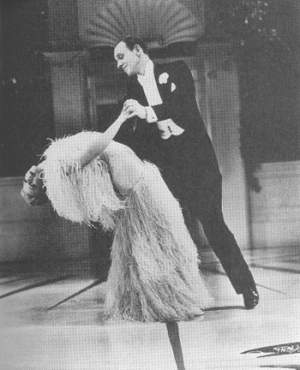


Ginger Rogers and Fred Astaire
Filmography | Lyrics | Articles | Awards | Downloads | Bibliography | Goofs | Statistics | Rankings | Links | Image Credits | Ginger Rogers | Fred Astaire
| Page 4 |
TOP HAT (1935) They're dancing Cheek-To-Cheek again!
|
Finally, this is what we've been waiting for! Once again, plot-wise things are a little strained (this is another case of mistaken identity), but as far as dancing goes, TOP HAT (1935) is quite an achievement. Things begin with Fred (as American dancer, Jerry Travers) arriving in London to do a show for producer Horace Hardwick (played by Edward Everett Horton, who was also Astaire's chaperone in THE GAY DIVORCEE). Jerry feels so liberated in jolly-old England that he breaks out dancing in his hotel room, tapping madly to "No Strings (I'm Fancy Free)." (It's one of Astaire's best dance solos in all the films.) He halts abruptly however, when he notices Ginger standing in the doorway to his room (in her night robe) and looking at him disapprovingly.
And the stage has been set. He's smitten, to say the least (love at first site à la GAY DIVORCEE -- in fact, much of this film resembles THE GAY DIVORCEE, from the mistaken identity plotline to the supporting actors including Horton, Erik Rhodes, and Eric Blore), and proceeds to appoint himself "her official sandman," doing a soft shoe reprise of "No Strings" on a bed of sand he has poured all over the floor (actually the contents of a hotel ash can). The next day, he sets out to get to know her better.
As it turns out, Ginger (here known as Dale Tremont) is a fashion designer's model. Still irked by his behavior the night before, she does all she can to avoid Jerry, but he's determined as well, and what better excuse to have to get acquainted than a thunderstorm that traps them on a bandstand in Hyde Park? "May I rescue you?" Jerry asks, arriving at the bandstand with an umbrella. "No thank you. I prefer being in distress," she replies. Isn't This a Lovely Day to be Caught in the Rain? |
 So Jerry sings "Isn't this a lovely day to be caught in the rain?" But Dale is slow to come around. Actually, the reason this dance sequence is so neat is not just its "conversation though dance" style, but Ginger's acting. She does a great job making the transition from put-out and pursued to obliging and even interested herself. In fact, what makes the comedy of this movie work (when it does), is her timing and fine abilities as a comedienne -- often overlooked and underrated, but essential to the success of all of their films together actually. A picture of the real bandstand in London's Hyde Park where the "Lovely Day" dance takes place in the film, although it was actually shot on a set on the RKO lot. Via various happenstances, Dale (after falling for him) comes to believe that Jerry is actually her friend Madge's husband (whom she's never met, but who is actually Horace, Jerry's producer). Upset and hurt, she knows better than to get involved with (the man she believes is) Madge's husband, and after telling Jerry off, thinks all is well when she's invited to spend the weekend with Madge at the Lido Hotel in Venice. |
Guess who's also invited? Unfortunately, while the dancing continues to impress, the plot begins to disappoint -- there's just not enough of it. Things slow down considerably in Venice because there's not enough happening story-wise to keep them moving, and the various episodes in which Dale should-but-doesn't find out that Jerry is not Horace get old. Is it really possible to go 90 of the 105 (or 101 in some cuts) minutes of the film without her figuring out who's really who? Even in THE GAY DIVORCEE the deception didn't last this long. And has anyone ever seen Venice looking so pristine as it does in this film? The art designers even dyed the water black to better contrast with this, another huge white set. But then again, who wants realism? It's supposed to be diversion, right? And actually, as charming as this film is, we tend to forgive its weaknesses. Well, as I said, it's the dancing that continues to impress in TOP HAT. There's another solo by Fred (back in London) to "Top Hat, White Tie and Tails" in which he creatively shoots down a chorus of his fellow dancers with his cane (the sound effects being provided by his feet). And the big production number finale which had become a standard in the films after RIO's "The Carioca" and DIVORCEE's "The Continental" was called "The Piccolino" in this film. Fred didn't like it and handed it down, so Ginger sings it (rather randomly), and to be honest, the lyrics aren't much more than arbitrary Italian words thrown in for their easy rhyming (casino, bambino, vino, etc.), but the dance is neat and Ginger's sparkling-skirted dress makes a nice statement as well. |
Feathers. Few of Ginger and Fred's romantic duets are as famous as the "feathers" number -- "Cheek to Cheek" ( As was her custom by now, Ginger and dress designer Bernard Newman consulted on what she should wear for the number, and they agreed upon a form-fitting blue satin dress with "myriads of ostrich feathers, low in the back and high in the front."(*1) Ginger started rehearsing and Newman set out to produce the dress. The difficulties started during the "dress" rehearsal however. As Fred explains:
Unfortunately, wardrobe had a little difficulty with the feathers, and the dress wasn't ready until time for the shoot. According to Ginger, Fred and director Mark Sandrich began to complain about it as soon as it was delivered: "'What is it? A bird? A plane?' 'No, it's Ginger's dress!'"(*3) As she was about to put it on, Sandrich came to her dressing room and told her he didn't think it was right for the scene. He suggested that she wear her white dress from the "Night and Day" number in THE GAY DIVORCEE and had it brought down from storage. Ginger was upset by this affront to her taste and judgment and decided to fight for the dress, but Fred, Sandrich and the crew were all against her. She became so overwhelmed at how out-numbered she was as the argument progressed (by now, five men from RKO's front office were also involved), that she called her mother, Lela, who came down to studio to lend her support. Eventually things became so heated that Ginger and her mother walked off the set. They didn't return until Sandrich agreed to let her rehearse the number in the blue feather dress. In Fred's version, there was no trouble until they actually began rehearsing with the dress. "Everything went well through the song, but when we did the first movement of the dance, feathers started to fly as if a chicken had been attacked by a coyote."(*4) According to Ginger, there were difficulties with flying feathers, but it wasn't that bad. In either case, after a little more rehearsing, sewing, shaking, and sweeping, the cameraman finally decided just to shoot the number and see how it came out in the rushes the next day. The rushes were fine and the trauma was over. (A few loose feathers are visible in the number, but only if you're looking for them really.) There were still a few hard feelings on both sides however. Fred and choreographer Hermes Pan mocked the incident by singing (to the tune of "Cheek to Cheek"(
Ginger didn't take too kindly to this or to the general cold-shoulder she felt she was getting from Sandrich and the crew, but Fred made it up to her. A few days after the incident, a small white box was delivered to her dressing room containing a little gold feather for her charm bracelet and a note that said, "Dear Feathers, I love ya! Fred."(*6) He later referred to the whole episode as a "running gag with Ginger and me" and even started calling her "Feathers."(*7) Usually regarded as the second-best of the series (behind SWING TIME the following year), TOP HAT received four Academy Award nominations in 1935 -- more than SWING TIME (1936), but less than THE GAY DIVORCEE (1934). Though it didn't win any Oscars, the nominations included one for Carroll Clark and Van Nest Polglase's art (deco) direction as well as a Best Song nomination for Irving Berlin's "Cheek to Cheek" ( Footnotes: |
Go to the next page. |
| Current Contest Prize: |
|---|
| Now in Print! |
|---|
| Now on DVD! |
|---|
Buy Videos & DVDs |
|
Buy Movie Posters |
|
Buy Movie Posters |
|
Classic
Movie Merchandise |
|
![]() Printer-friendly version.
Printer-friendly version.
![]() Return
to the top.
Return
to the top.
Last updated:
December 16, 2008.
Reel Classics is a registered trademark of Reel Classics, L.L.C.
© 1997-2009 Reel Classics, L.L.C. All rights reserved. No
copyright is claimed on non-original or licensed material.
Terms of
Use.













